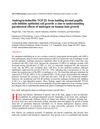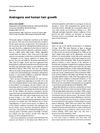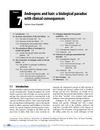TLDR Male pattern baldness is caused by certain cells in hair follicles and could potentially be treated by targeting a specific growth factor, TGF-β1.
The 2003 study "Pathomechanism of androgenetic alopecia and new treatment" investigated the causes of androgenetic alopecia (male pattern baldness) and potential treatments. The research discovered that hair growth is regulated by paracrine regulation, with dermal papilla cells (DPCs) in hair follicles being the target cells for androgens. These DPCs express androgen receptor and type II 5a-reductase mRNA. The study also found that androgens stimulate the growth of keratinocytes in beard DPCs, suggesting the production of androgen-dependent growth factors, including Insulin-like growth factor-1 (IGF-I). However, androgens were found to inhibit the growth of keratinocytes in DPCs from the balding frontal scalp, mediated by TGF-β1 from the DPCs. The study concluded that TGF-β1 could be a potential target for new treatments of androgenetic alopecia. At the time, two treatments, Minoxidil and Finasteride, were recently introduced for androgenetic alopecia.
 190 citations
,
October 2002 in “The FASEB journal”
190 citations
,
October 2002 in “The FASEB journal” Androgens may cause hair loss by increasing TGF-beta1 from scalp cells, which inhibits hair cell growth.
 66 citations
,
April 2002 in “Journal of The American Academy of Dermatology”
66 citations
,
April 2002 in “Journal of The American Academy of Dermatology” Finasteride increases hair weight and count in men with hair loss.
 83 citations
,
December 2001 in “Journal of Investigative Dermatology”
83 citations
,
December 2001 in “Journal of Investigative Dermatology” Minoxidil boosts hair growth by targeting adenosine and possibly sulfonylurea receptor 2B.
73 citations
,
November 2000 in “Proceedings of the National Academy of Sciences of the United States of America” There are two ways to start hair growth: one needs Stat3 and the other does not, but both need PI3K activation.
173 citations
,
July 1995 in “Biochemical and biophysical research communications” Male hormones promote hair cell growth by using a growth factor from nearby skin cells.
48 citations
,
April 1995 in “PubMed” Testosterone helps beard and axillary hair cells grow by releasing growth factors from dermal papilla cells.
February 2015 in “American journal of medical and biological research” Balding hair follicles have less growth-promoting factors and more inhibitory factors, leading to hair loss.
 157 citations
,
April 1994 in “Clinical endocrinology”
157 citations
,
April 1994 in “Clinical endocrinology” Androgens can cause hair growth in some areas and hair loss on the scalp.
1 citations
,
January 2022 in “Springer eBooks”  8 citations
,
July 2012 in “Cambridge University Press eBooks”
8 citations
,
July 2012 in “Cambridge University Press eBooks” Androgens can both increase body hair and cause scalp hair loss.
 August 2025 in “Annals of Medicine”
August 2025 in “Annals of Medicine” Extracellular vesicles show promise for treating hair loss but need more research for effective use.








